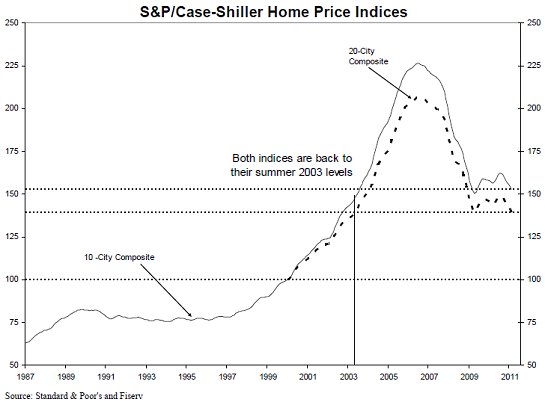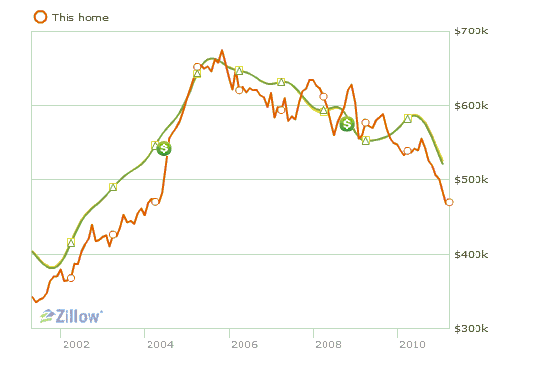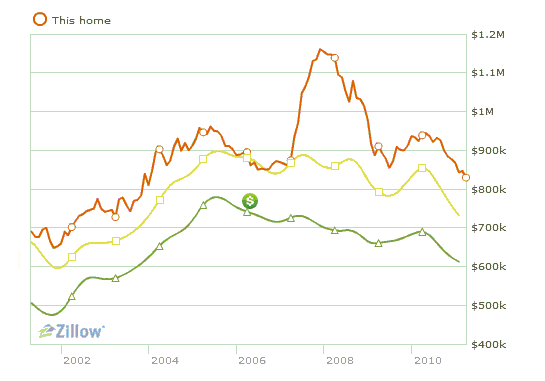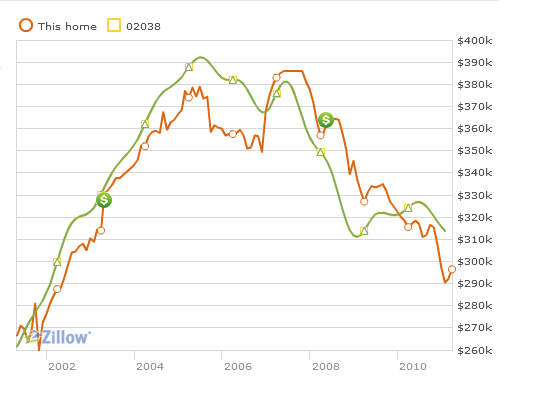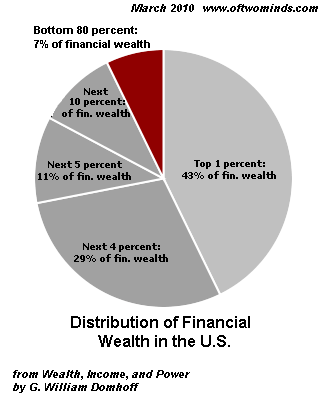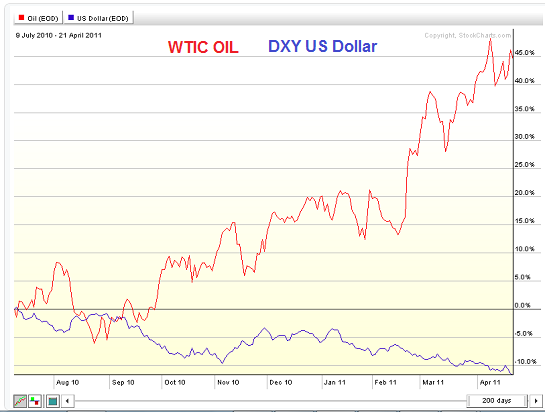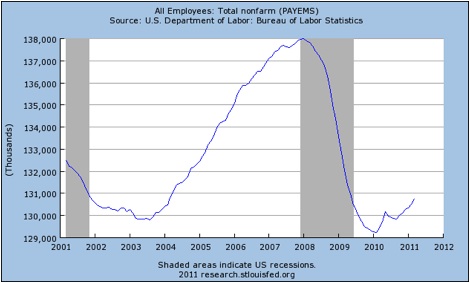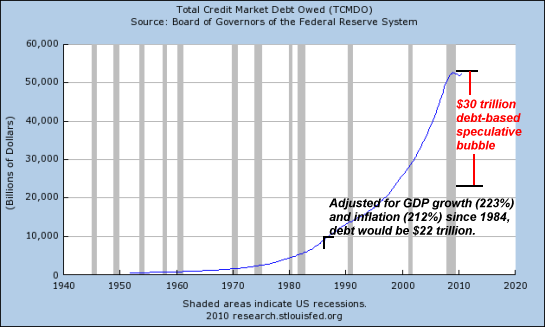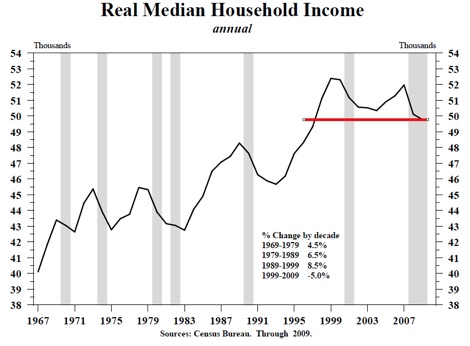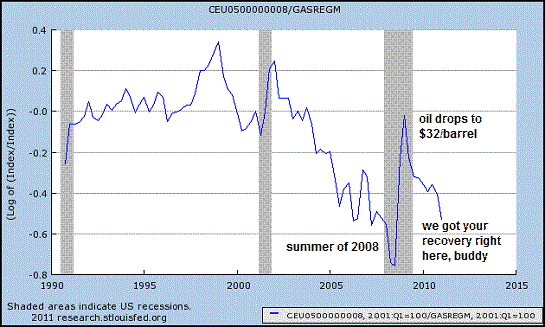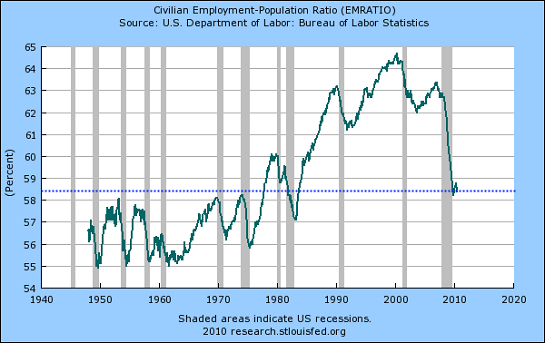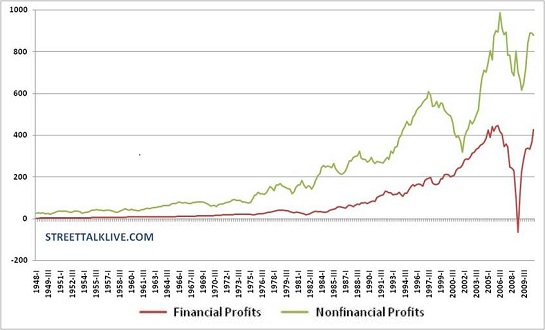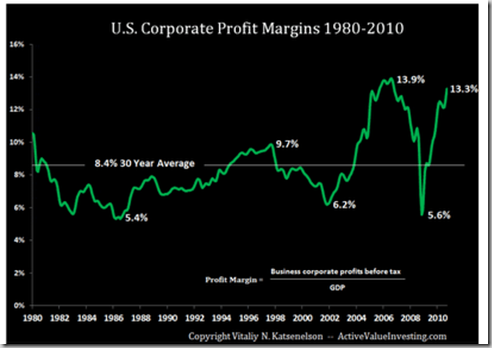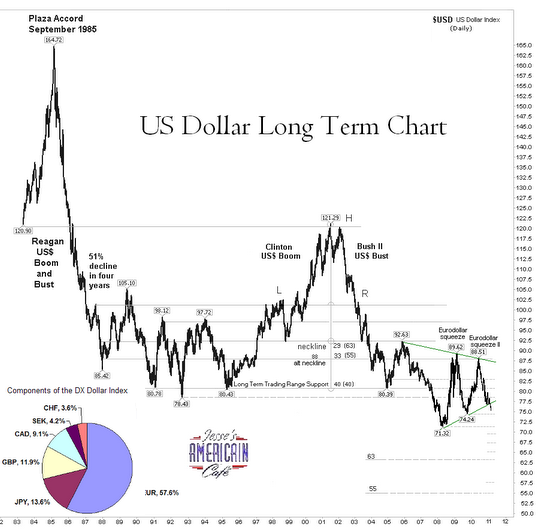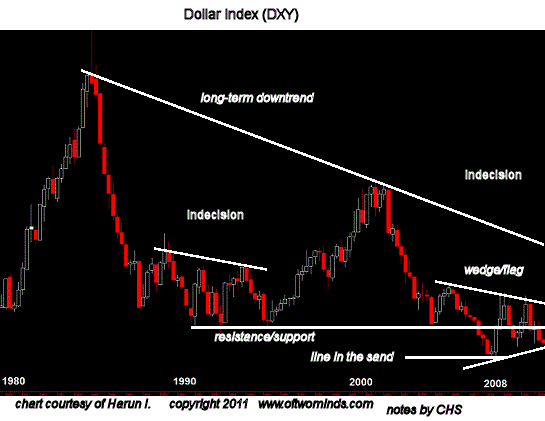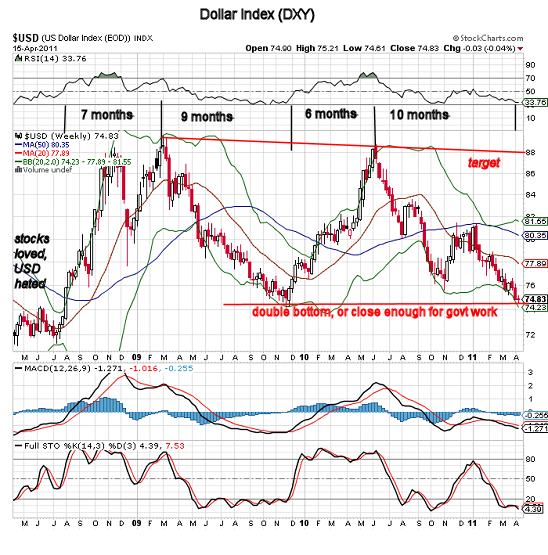How much gold would an individual investor need as a hedge against the total depreciation of fiat currencies? Here is a back-of-the-envelope calculation.
My view that gold is a prudent hedge is well-established in my archives. For example, from 2006: Gifts and Gold (December 9, 2006) (promoting the idea of giving gold as a gift):
Recently, another friend asked if I was a "gold bug." I said, no, I wasn't. But I did say I thought it prudent to own some actual physical gold and some mining stocks or a gold ETF, and maybe some silver if you follow that metal or consider gold and silver roughly equivalent. As shown here this week, all currencies are declining against gold. Nuff said.
Beneath the Surface, Part III: The Dow and Gold (November 29, 2006)
From approximately 1980 through 2002, the ratio of the Dow and gold moved in sync (i.e. was in correlation) with the Dow Jones Industrials. But since the market low in 2002, the two have radically diverged.
Now it is always possible that a historic correlation has been broken. But it behooves those of us trying not to lose whatever capital we might have in this world to consider an alternative: that the divergence will return to convergence.
(Discussion of how this could be achieved: either the dollar strengthens or gold rises.) The likelier possibility is a collapse in the dollar and a doubling of the price of gold.
At the time that was written, the gold/Dow ratio was 20--now it is 8.3 (Dow 12,500, gold $1,500). In other words, the divergence has only widened.
This raises an interesting question: how much gold would be needed as a prudent hedge against the total depreciation of fiat currencies? I recently conducted a back-of-the-envelope thought experiment on this topic in the Weekly Musings (for subscribers/major contributors).
Here is an outline of the thought experiment and calculations. Please note this is NOT A RECOMMENDATION TO BUY OR SELL ANYTHING, it is a thought experiment presented as "food for thought." Please read the HUGE GIANT BIG FAT DISCLAIMERbelow.
Starting point assumption: There is some probability (low or high is a matter of judgment) that as a result of the fundamental imbalances in the current global financial system, all fiat currencies will depreciate to near-zero. This is also referred to as hyperinflation or loss of faith in paper money.
A persuasive case can be made that this is not a probability but the inevitable end-game of the Status Quo: Deflation or Hyperinflation (FOFOA).
A 27-page analysis Apropos of Everything, Parts II & III reaches the same conclusion, while also making a strong case that the only functional, practical choice as a replacement for debased paper currencies is a gold-backed currency.
I have been persuaded of this since reading Gold: The Once and Future Money by Nathan Lewis, who has kindly corresponded with me on a variety of topics.
This book is an extremely readable history of money, gold and the politics of monetary policy as well as a carefully reasoned explanation of why gold-backed currencies provide stability. (Some argue that the 19th century booms and busts prove this wrong, but those booms and busts were credit-based. But I digress.)
I have also speculated here on the possibility that the private sector would lead the way to gold-backed currencies by establishing a non-State gold-backed "note."
Some readers have said that gold itself is money, but this isn't the point: the point is that trade over great distances requires a trusted medium of exchange, be it "commercial paper" or some other promissory note that can be exchanged to buy and sell real goods. This has been true since the rise of modern capitalism in the 1500s. (For more on this topic, please read this wonderful three-volume history of early Capitalism: The Structures of Everyday Life (Volume 1)
The Wheels of Commerce (Volume 2)
The Perspective of the World (Volume 3)
The point here is that there is a possibility that all fiat currencies will experience a loss of faith/rapid depreciation as the Status Quo devolves. Please read the above article links for more.
You don't have to judge this as likely to consider a hedge, you simply have to assess it as possible.
So how much gold would a household need to hedge their paper wealth against depreciation? In Apropos of Everything, Parts II & III Paul Brodsky reckoned that gold at $10,000 an ounce would enable the U.S. to back its current money supply with the 256 million ounces of gold it holds in reserve.
That is one rough approximation of how much gold one would need to hold to hedge paper financial assets. If gold were to rise 6.6-fold from $1,500 to $10,000, then $10,000 of gold at today's price (6.6 ounces in US dollars) would hedge $66,000 in paper financial capital.
In other words, after the dollar (and other paper currencies) fell into the black hole and disappeared over the event horizon, then the 6.6 ounces would be equal in purchasing power to the $66,000 in paper assets that just vanished.
I know there are many other complicating factors, but this is a rough calculation.
I reached a different conclusion by following the idea presented by Brodsky that gold-backed money would have to equal all the current paper money.
First, let's take all current financial net worth (assets minus liabilities) in the U.S. which according to the Fed Flow of Funds is about $35 trillion. (Net fixed assets such as real estate are about $10 trillion.)
Total financial assets are $47 trillion, but these include corporate equities and non-corporate business assets which include factories, production facilities, etc. owned by the corporate and non-corporate enterprises. These tangible assets would still retain their utility value after the "event horizon" depreciation, so I don't think they should be included in purely paper financial assets such as stocks based on "blue sky," bonds based on future promises of payment, etc.
If you disagree, then take the $47 trillion number as a starting point. Or if you reckon corporate profits are an income stream that will retain value after a fiat currency depreciation, then feel free to adjust the financial assets down to whatever number you think approximates the financial wealth that would be lost in a stick/slip "black hole" currency depreciation.
The U.S. has about 25% of the world's wealth, so let's multiply the $35 trillion in purely financial capital by four: thus the global economy has about $140 trillion in purely financial wealth (pension funds' holdings of blue-sky stocks, bonds, etc.)
Once again, this is all back-of-the-envelope.
There are about 5.3 billion ounces of gold "above ground," roughly 160,000 tons. At the current price of $1,500 an ounce, all the available gold is worth about $8 trillion. About half is in jewelry, 10% in industrial uses and 40% as central bank reserves and investment.
If gold took the place of fiat currencies as "money," the available gold would have rise to about $140 trillion in value. In today's dollars, that's about 18 times its current price. So $1,500 X 18 = $27,000 an ounce.
Let's round that off to $25,000 an ounce. (Feel free to round it up to $30,000 if you prefer.) If you prefer to subtract industrial gold or other uses from the calculation, then the number will be much higher. I am presenting the idea as simply as possible.
To hedge $250,000 in paper financial wealth (recall that productive real estate, windmills, factories, etc. would still retain their productive utility value after currency depreciation), you would need 10 ounces of gold, or $15,000 worth at today's prices.
Though we cannot be sure of much in the world, we can be fairly certain that gold will not go to zero value. Thus owning gold is not like owning a futures contract which expires.
Let's say total fiat currency depreciation never occurs, and instead gold falls 50% in dollar-denominated value to $750/ounce. Many consider this very unlikely, just as others think a loss of faith in the dollar is a near-impossibility. Both are possibilities, regardless of the odds anyone places on them at any one moment in time.
Then the hedge against complete destruction of paper money would have cost $7,500, in "opportunity cost" if nothing else. That's a relatively modest price for $250,000 of "portfolio insurance" via a hedge that doesn't expire.
To complete the thought experiment: it doesn't really matter if the "new dollar" or quatloo are whatever is backed by gold or not; it might be a "hard currency" based on limited circulation, or some other scheme. The point is that if the present currencies suffer significant depreciation, then gold will reflect that.
In other words, if one "new dollar" replaces 20 devalued dollars, then gold will be worth 20 X $1,500 or $30,000 an ounce when the "new dollar" is imposed. Gold needn't be the "official money" at all to act as money.
Is now a good time to establish a gold hedge? I have no idea. I have no idea what will happen, tomorrow or next year or five years from now-- to the price of gold in dollars, to the value of dollars in other currencies, or anything else for that matter. Me only pawn in game of life. The thought experiment is an exploration of hedging, it is not a speculation on the future price of anything.
Please note this is NOT A RECOMMENDATION TO BUY OR SELL ANYTHING, it is a thought experiment presented as "food for thought." Please read the HUGE GIANT BIG FAT DISCLAIMER below.
HUGE GIANT BIG FAT DISCLAIMER: Nothing on this site should be construed as investment advice or guidance. It is not intended as investment advice or guidance, nor is it offered as such. It is solely the opinion of the writer, who is NOT an investment counselor/professional. All the content of this website is solely an expression of his personal interests and is posted as free-of-charge opinion and commentary. If you seek investment advice, consult a registered, qualified investment counselor (As with any other professional service, confirm their track record and referrals).
Readers forum: DailyJava.net.
Order Survival+: Structuring Prosperity for Yourself and the Nation (free bits) (Mobi ebook) (Kindle) or Survival+ The Primer (Kindle) or Weblogs & New Media: Marketing in Crisis (free bits) (Kindle) or from your local bookseller.
Of Two Minds Kindle edition: Of Two Minds blog-Kindle
| Thank you, Pam & Pat ($25), for your long-standing generosity to this site-- I am greatly honored by your friendship, support and readership. | | Thank you, Jim L. ($50), for yet another outrageously generous contribution to this site-- I am greatly honored by your ongoing support and readership. |
 Peak Oil and Soil (August 1, 2007) by Eric Andrews is a wonderfully succinct explanation of the connection between Peak Oil and its offspring, Peak Soil and Peak Food. Relying on the centralized powers of Big Agriculture and Big Government to "save us" might not be a wise strategy; there are decentralized paths to a less risky, more sustainable mode of food production.
Peak Oil and Soil (August 1, 2007) by Eric Andrews is a wonderfully succinct explanation of the connection between Peak Oil and its offspring, Peak Soil and Peak Food. Relying on the centralized powers of Big Agriculture and Big Government to "save us" might not be a wise strategy; there are decentralized paths to a less risky, more sustainable mode of food production.




















